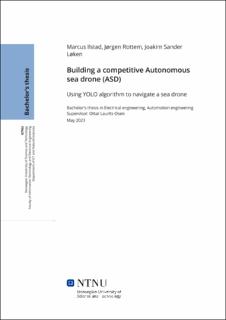Building a competitive Autonomous sea drone (ASD)
Bachelor thesis
Permanent lenke
https://hdl.handle.net/11250/3076963Utgivelsesdato
2023Metadata
Vis full innførselSamlinger
Sammendrag
Formålet med dette prosjektet er å bygge en Autonom Sjødrone (ASD) slik at den kan ta del i Autodrone,en konkurranse i Horten.YOLOv8-algoritmen ble brukt til å trene en liten YOLO-modell, som deretter ble brukt til bøyedeteksjon.Prosjektet produserte et ASD som er i stand til å oppdage bøyer, konvertere deteksjonene til GPS-posisjoner, og navigere basert på denne informasjonen. På grunn av problemer med ZED2-kameraets dybdeoppfatning, var ASDen ikke i stand til å utføre sine oppgaver på en pålitelig måte.
For å skape en ASD som er både mer effektiv og pålitelig enn tidligere design, er både det fysiske designet og elektriske designet helt omgjort fra de tidligere designene som ble gjort ved NTNU i Ålesund. The purpose of this project is to build a capable ASD so that it can take part in the Autodronecompetition in Horten. Machine vision will be utilized in order to allow the ASD to successfullynavigate through the missions. The YOLOv8 algorithm was utilized to train a small YOLO model,which was then used for buoy detection.The project produced an autonomous surface vessel (ASD) that is able to detect buoys, convertthe detections to GPS locations, and navigate based on this information. Because of certain issueswith the ZED2-camera’s depth perception, the ASD was unable to perform its duties in a reliablemanner.In order to create an ASD that is both more effective and reliable than previous designs, the ASD’sphysical design and electrical design were both completely rethought from the earlier designs doneat NTNU in Aalesund.
